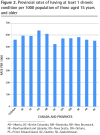Ecology of health care in Canada
Abstract
Objective: To provide a population-based, Canada-wide picture of health care needs and health care use, and present it in a highly accessible manner, allowing provincial comparisons and comparisons with other international jurisdictions.
Design: A comparison of the rates of health care use among jurisdictions, using Canadian-population survey data and health administrative data.
Setting: Provincial jurisdictions across Canada.
Main outcome measures: Canadian and provincial rates of ill health (presence of chronic conditions) and health care use (contacts with family physicians, contacts with other specialist physicians, contacts with nurses, and hospitalizations) as monthly rates per 1000 population standardized by age and sex.
Results: The monthly rate per 1000 population of having at least 1 chronic condition ranged from 524 in Quebec to 638 in Nova Scotia; contacts with family physicians ranged from 158 in Quebec to 295 in British Columbia; contacts with other physician specialists ranged from 53 in Saskatchewan to 79 in Ontario; and contacts with nurses ranged from 23 in British Columbia to 41 in Quebec. Hospital stays ranged from 8 to 11 per 1000 people, and rates were similar among the provinces.
Conclusion: Recognizing the differences among jurisdictions is critical to informing health care policy across the country. Differences persisted when rates were standardized for different age and sex compositions in the provinces. This article provides a straightforward methodology using publicly available data that can be employed in each province to examine, in the future, the evolution over time of health care use by provincial jurisdictions.
Copyright© the College of Family Physicians of Canada.
Figures



References
-
- White KL, Williams TF, Greenberg BG. Ecology of medical care. N Engl J Med. 1961;265(18):885–92. - PubMed
-
- Green LA, Fryer GE, Jr, Yawn BP, Lanier D, Dovey SM. The ecology of medical care revisited. N Engl J Med. 2001;344(26):2021–5. - PubMed
-
- Statistics Canada [website] Canadian Community Health Survey—annual component (CCHS) Ottawa, ON: Statistics Canada; 2008. Available from: www.statcan.gc.ca/cgi-bin/imdb/p2SV.pl?Function=getSurvey&SurvId=3226&Su.... Accessed 2015 Mar 18.
-
- Canadian Institute for Health Information [website] Quick stats. Inpatient hospitalizations: volumes, length of stay, and standardized rates. Ottawa, ON: Canadian Institute for Health Information; 2015. Available from: www.cihi.ca/CIHI-ext-portal/internet/EN/applicationfull/types+of+care/ci.... Accessed 2015 Mar 18.
-
- Statistics Canada [website] Age groups (13) and sex (3) for the population of Canada, provinces and territories, 1921–2006 censuses—100% data. Ottawa, ON: Statistics Canada; 2014. Available from: www12.statcan.ca/census-recensement/2006/dp-pd/tbt/Rp-eng.cfm?LANG=E&APA.... Accessed 2015 Mar 18.
MeSH terms
LinkOut - more resources
Full Text Sources
Miscellaneous
